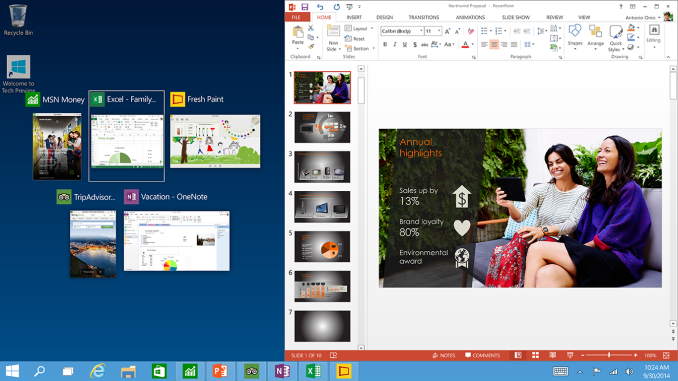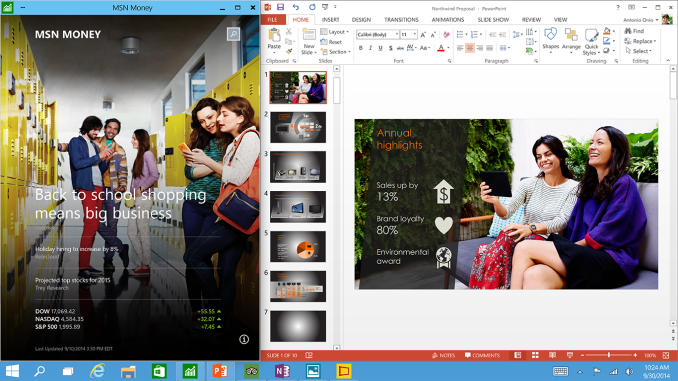Windows 10 Technical Preview First Impressions: The Return Of The Desktop
by Brett Howse on November 13, 2014 8:00 AM EST- Posted in
- Software
- Microsoft
- Windows 10
Closing Thoughts
If Windows 8 was “Touch First” then clearly Windows 10 is not. The current technical preview is very much geared towards the traditional mouse and keyboard user. This will change of course over the next several months, as the touch features get integrated back into Windows 10. As a user of all types of Windows devices, I welcome this change. It allows me to be more productive on my desktop, but still use the touch based Start Screen on a tablet or convertible notebook. Some good things have been done here to hopefully embrace the current user base, as well as new device types.
There are a number of features aimed squarely at businesses. If Microsoft wants to avoid another Windows XP with Windows 7 – where businesses do not migrate until they absolutely have to – then these features are certainly a carrot that may entice them to at least try it out. The Start Menu and other desktop additions will be great for the business users, and I think the IT crowd will be happy with a lot of the new additions around device management, identity management, and information management.
This is a technical preview of course, but still I would be remiss to not mention that it is not without its bugs. I have had a lot of issues with Windows Store apps, with many of them crashing especially when they are not the active window. Possibly there are some changes to the underlying WinRT framework for apps in standby but until we hear more about the framework changes then these problems will likely continue. More of this information should come out around the time of the next BUILD conference, scheduled for April 29th to May 1st 2015. Other issues with WinRT apps currently is that even though they can be used in a window, the absolute height of the window is limited. When Windows 8 was launched, WinRT apps were expecting to be either full screen, or snapped to the side. As such, the apps in a window must maintain a minimum height. Hopefully this can get sorted out in the future.
At first glance, Windows 10 looks like Windows 8 with a Start Menu. It is clearly a lot more than that, but even so, as someone very smart told me, that’s not a bad thing. Windows 8 had a lot going for it, but design decisions were made early on, and with a “my way or no way” attitude that it was difficult to use. It seems that Windows 10 really addresses a lot of this, while at the same time keeping and expanding on a lot of the great features that were in Windows 8 and likely overlooked due to a lot of animosity towards it.
The Windows Store is going to be a big part of this, and if the rumors of desktop apps being integrated into the store is true, then the OOBE for Windows 10 will be amazing. All of your settings and apps will now follow you from device to device, with a single log in. A lot of that is already there with Windows 8, but 10 should finish off the last remaining pieces if this is true. It makes a lot of sense, so unless the licensing terms are awful, this could be a fantastic addition to the store.
The Universal App model is also a big piece of the puzzle, but here there is more work to do. WinRT has a lot of advantages, but the framework needs to be updated at a rapid pace in order to draw developers in. It is somewhat seductive to be able to target desktops, laptops, tablets, phones, and the TV with Xbox One with a single application (with multiple interfaces of course) but until the framework is made powerful enough for more apps than just simple web front ends, it may be difficult to realize this idea. Once again, more info should be available at BUILD in regards to this.
I’ve also had some bugginess with the WinRT apps on Windows 8, which I hope will be fixed with Windows 10. At this point though, the WinRT apps are even buggier so likely there will be more pain before this is all corrected.
Although we have only seen the Technical Preview and a single update to it so far, you can see the potential for Windows 10 and what it will be able to accomplish. It is an ambitious goal to provide a single platform across such a swath of different devices, and one that was held back by the user interface before. With Continuum, it appears that it may be the best of both worlds. Even more exciting is how much more upfront and open Microsoft has been on this entire process, with not just the technical preview but also soliciting and requesting user feedback on the changes. One of the biggest change requests was a simple animation on the Start Menu, and that has already been implemented, so this really is a different world than when Windows 8 was given a sneak peek.
Due to the timing of the latest release that just came out, this article is based on the second build of Windows 10 and I have not had a chance to go over any of the changes in the latest built that arrived on November 12th.
Going forward, as we get more updates to the preview we will do our best to keep you fully informed with that the changes are, and how they will affect you. If you want to kick the tires of Windows 10 and you have not yet, just visit http://preview.windows.com and sign up for the technical preview.












198 Comments
View All Comments
JonnyDough - Friday, January 16, 2015 - link
Microsoft will just force you to switch as they did before. They will drop support and remove updates from the internet so that you can't even patch your old OS to last year's security level.CaedenV - Thursday, November 13, 2014 - link
I have been playing with 10 in a VM on my desktop off and on, and it has been pretty awesome so far. I do wish they would have gone with something more like the WP Start menu and give the option between that and the 'traditional' win7 style menu rather than having tiles endlessly (and annoyingly) sprawl off to the right, but outside of that everything else has run very smoothly.Can't wait for winter break when I will be able to risk installing on my Dell XPS12 to get a feel for the touch and form factor switching capabilities of continuum. That is what is going to make or break this version for mainstream users (who by in large like win8.1). But for business and pro use win10 is already going to be a big step forward compared to 8.
kamm2 - Thursday, November 13, 2014 - link
I know so many people who will not buy Windows 8 computers because of two reasons. The Start screen is one even though I tell people they can install a free app to get the W7 start menu back. The second being that W8 is ugly. From what I've seen this will still be an issue with W10.darthrevan13 - Thursday, November 13, 2014 - link
Flat is the new trend on the web because of everything now need to be responsive to the screen size/window size. Android and iOS became more flatter because of that. If you're hoping for Win 7 style Aero 3D effects then I think you're going to be dissapointed by all OSes, except Linux perhaps, if you have the time to invest customizing your interface.kamm2 - Thursday, November 13, 2014 - link
There is a lot that can be done between the two and flattening an interface does not necessarily mean it has to look ugly. Less appealing to some sure but there are ways to minimize that. iOS 8 and Lollipop does not stir up such a strong dislike. It also doesn't help sales that whenever a W8 device is displayed in an ad there's that loathed start screen staring at you.kyuu - Friday, November 14, 2014 - link
Funny, I think iOS8 is a pretty horrid mishmash of iOS's chiclet-tiles on a grid with modern flat design principles that ends up being pretty ugly. Lollipop simply makes Android look a lot more like Windows 8, really. They certainly did a better job of going flat than Apple did.And I really, really don't get the hate for the start screen's aesthetics. In what way is it worse than iOS and Android's tiles-on-a-grid?
steven75 - Friday, November 14, 2014 - link
It's purely subjective. It just happens to be that you are very much in the minority. Nothing wrong with that.GuardianAngel470 - Saturday, November 15, 2014 - link
Two reasons: 1) Color Clash. Any half-way fashion/home design/color design-conscious person can tell you that some colors should simply not show up next to each other.Windows Phone 7 (the grandfather of ModernUI) didn't have this problem. It had a unified color interface; you picked your color, and all buttons on the start screen were that color. Occasionally some apps would change on you depending on their activity, but the buttons were typically all the color you chose for them.
Windows 8 changed that. Boot up the computer for the first time and you're confronted with half a dozen different pastel colors, many of which clash horribly. It's like looking at a hip woman from the 80's; complete color-induced eyestrain.
2) Massive wasted space. This is an issue I personally have with it, and I'm not sure if anyone else does. Essentially, on a 24+ inch monitor, Windows 8 wastes massive amounts of space. Huge swaths of the Start Screen are just a solid color background. Most of the app buttons are empty space. Apps themselves (back when they were fullscreen by default) had about a 3 to 1 ratio of unused space to relevant info/interface.
Personally, I HATE that. Maybe it's just OCD of me, but I hate wasting space like that. It's physically irritating when it does that. That I couldn't stop it was even worse.
8.1 didn't really help with that either.
inighthawki - Thursday, November 13, 2014 - link
"because of everything now need to be responsive to the screen size/window size"That's funny, I haven't had this issue since... oh wait, never. Windows 7 works great. Flat graphics is a horrible invention of the web because web sites needed to be performant on extremely low end devices (because html, js, and CSS are garbage for performance compared to native code and hardware accelerated graphics), and low bandwidth connections. A desktop OS does not really have these issues. The windows desktop is fully composed using hardware acceleration on a heavily optimized compositor that supports things like occlusion.
kyuu - Friday, November 14, 2014 - link
Except that flat design has nothing to do with performance considerations. This is something that you (and a lot of other people) are essentially making up. Flat design is simply the way design is currently moving -- it's a break from the previous skeumorphism-heavy design ethos. It's a design choice, not a technical consideration. Any performance benefit (from not having to render fake-3D effects and transparencies) is merely tangential.